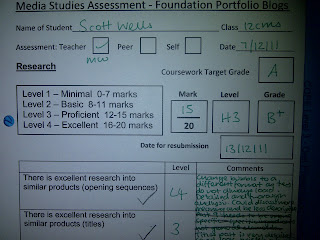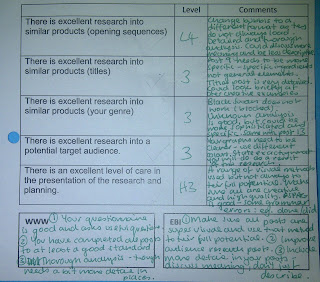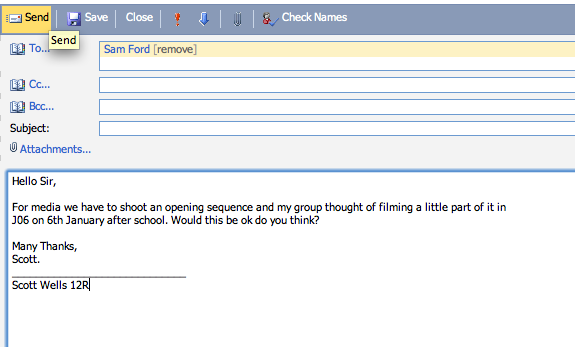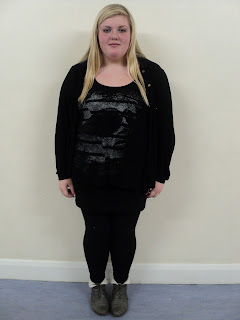Here are the shots of which we want to include in our opening sequence to our Psychological thriller:

 Extreme long shot/ Establishing shot:
Extreme long shot/ Establishing shot:Both of these shots are similar in the way that they both reveal a lot about the location but don't really focus on what the characters are doing. By doing this it points out to the audience that this is a key location and to pay attention to it. The other purpose of this shots is to set the scene so the audience know exactly where the film is set.
 Two Shot:
Two Shot:We want to possibly use this shot in order to show the body language of two characters at the same time. This can also show the relationship between the two as if they're close we know they are comfortable with one another, if they were far away we would pick up on it.

Over the shoulder:
The effect of this shot gives the audience a different perception and view on the situation and also the other character. It makes the audience almost feel more of a part of the piece, engaging them and revealing the expressions effectively. Long shot:
A long shot allows the audience to really look at the character as it reveals all their costumes and still manages to communicate some of the facial features. The use of this can also give an insight into the character themselves; their attitude, personality and mood.

High angle:The use of a high angle makes the person/ character/ object appear small. This could communicate and illustrate isolation and vulnerability as its like the audience themselves are looking down, almost judging the person. This could be used effectively in our opening sequence to represent status and to enforce the atmosphere in certain circumstances.

Low Angle:The low angle completely contrasts with the high angle not just because it shows the character in a different light but by looking at the image there is a real sense of power and authority communicated from it. This could be used in our opening to show the status between the characters giving the audience an insight into them more.
Mid Shot:
Mid shots are effective in just generally presenting the character to the audience as they are still shown the top half of the body so they can still see some, yet limited body language but you focus more on the characters facial expressions and you can clearly see them. This would be good to use if we want to show both; expressions and body language.

Close Up:Close ups are ideal in revealing the characters facial expressions and identity. It lets the audience focus of their details and to clearly identify them for when they appear later on in the film. Close ups would be used to help create and add to a specific mood and atmosphere.

Big Close Up: This type of shot reveals more to the audience in a sense of detail and establishing expression. This specific shot could be used (just like the image) to present a character walking, this in a way will create a mysterious atmosphere as you cant identify the person; clearly linking in with the conventions of our chosen genre.
 Extreme Close Up:
Extreme Close Up:This shot type is commonly used in thrillers as it doesn't reveal to much of the characters identity, building up the mysterious atmosphere for the audience to be engaged by as it doesn't give away to much, making the audience want to watch on an get introduced into the character.

Dutch Tilt:
A dutch tilt can be used in our opening sequence to communicate confusion and establish a certain uneasy atmosphere. This will clearly go with our genre of a Psychological Thriller as these are commonly seen throughout them. This camera movement can be used in any camera shot to give a different, desired effect on the audience.
 Here is the assessment sheet that one of my teachers filled out whilst marking and evaluating my 'Research' posts. In order for them to fill this out, they had to look through my 'Research' posts on my blog, and find what I did well, and what could be improved. Once they looked at this section of my blog, they then gave it a mark out of 20, as well as the grade they believe I am working at the moment. As you can see I got 15/20 which is a B+. From this sheet I will take on board all of the imporvements and change them in order to improve my grade for the future.
Here is the assessment sheet that one of my teachers filled out whilst marking and evaluating my 'Research' posts. In order for them to fill this out, they had to look through my 'Research' posts on my blog, and find what I did well, and what could be improved. Once they looked at this section of my blog, they then gave it a mark out of 20, as well as the grade they believe I am working at the moment. As you can see I got 15/20 which is a B+. From this sheet I will take on board all of the imporvements and change them in order to improve my grade for the future.









































